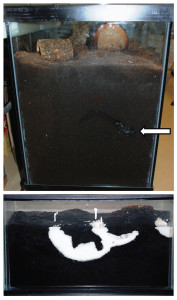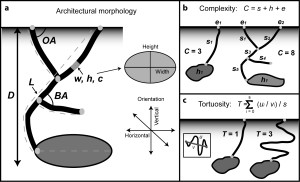Purpose
The purpose of the experiments conducted at the Ohio University Continental Ichnology Research Laboratory (CIRL) is to document the burrowing behaviors and biogenic structures of extant continental organisms, especially those that live in soils. These data are primarily used to better interpret similar trace fossils occurring in continental sedimentary rocks. The identity of the tracemakers and the behaviors involved in the production of trace fossils are typically inferred from the morphology (or form) of the trace. These interpretations require knowledge of the types of traces produced by organisms in the modern; this is the science of neoichnology. While these interpretations are often taken at face value, experimental and direct observational data to support these interpretations is often limited, especially with soil animals. A growing number of studies, however, are improving our understanding of burrowing organisms in all environments. To learn more about the study of neoichnology, please refer to the Neoichnology and Trace Fossils page.
Experimental Design
The species selected include those from a range of environments and ecological niches. Multiple individuals (5-25) of each species are obtained for study, typically from commercial sources. The individuals of each species include both males and females and are mostly mature adults with a range of sizes. The animals are allowed to acclimate to the laboratory conditions for up to one month prior to the start of the experiments. Temperature and humidity are maintained at near optimal levels for each species and a 12-hour light-dark cycle is kept in the laboratory. Food (typically apples and crickets) and water are made available depending on the needs of each animal, but the animals are handled as little as possible to limit conditioning and the altering of natural behaviors.
 The experiments are designed to observe the burrowing techniques of each species, document any surface features produced, observe the behaviors associated with any traces produced, and document the basic burrow morphologies through the production of three-dimensional casts once the animals had been removed. One to five specimens are placed in sediment-filled 19 L (30L x 15W x 20H cm), 38 L (51L x 27W x 32H cm), 76L (62L x 32W x 42H cm), 114L (80L x 30W x 40H cm), and 212 L (76L x 46W x 64H cm) terrariums for periods of 7–60 days. Specimens from each species are placed in small to large terrariums to test the effects of available space on animal behavior and burrow morphology. Those animals that exhibit gregarious or communal behavior are placed in experimental tanks individually and in groups to evaluate the effects of group behavior on burrow morphology. The experiments are designed to expose the animals to different environmental parameters including soil composition, soil density, and soil moisture. The sediment is composed of varying concentrations of medium- to fine-grained quartz or carbonate sand, clay, and organic matter. The density of the sediment was defined as low (0.4–0.7 kgf/cm2), moderate (1.1–1.4 kgf/cm2), and high (2.1–3.2 kgf/cm2). Soil moisture was varied from 0–94%. Sediment moisture was maintained by spraying the surface of the tank daily with 100–300 mL of water to make up for evaporative water loss. The density and moisture of the sediment were quantified using a Field Scout SC900 Soil Compaction Meter (Spectrum Technologies Inc.) and an Aquaterr EC-300 Salinity Multimeter, respectively. Measurements were taken every 10–15 cm to ensure homogeneity of the properties.
The experiments are designed to observe the burrowing techniques of each species, document any surface features produced, observe the behaviors associated with any traces produced, and document the basic burrow morphologies through the production of three-dimensional casts once the animals had been removed. One to five specimens are placed in sediment-filled 19 L (30L x 15W x 20H cm), 38 L (51L x 27W x 32H cm), 76L (62L x 32W x 42H cm), 114L (80L x 30W x 40H cm), and 212 L (76L x 46W x 64H cm) terrariums for periods of 7–60 days. Specimens from each species are placed in small to large terrariums to test the effects of available space on animal behavior and burrow morphology. Those animals that exhibit gregarious or communal behavior are placed in experimental tanks individually and in groups to evaluate the effects of group behavior on burrow morphology. The experiments are designed to expose the animals to different environmental parameters including soil composition, soil density, and soil moisture. The sediment is composed of varying concentrations of medium- to fine-grained quartz or carbonate sand, clay, and organic matter. The density of the sediment was defined as low (0.4–0.7 kgf/cm2), moderate (1.1–1.4 kgf/cm2), and high (2.1–3.2 kgf/cm2). Soil moisture was varied from 0–94%. Sediment moisture was maintained by spraying the surface of the tank daily with 100–300 mL of water to make up for evaporative water loss. The density and moisture of the sediment were quantified using a Field Scout SC900 Soil Compaction Meter (Spectrum Technologies Inc.) and an Aquaterr EC-300 Salinity Multimeter, respectively. Measurements were taken every 10–15 cm to ensure homogeneity of the properties.
Experiments commence with the placement of an animal into an experimental enclosure. Observational data collected during initial burrowing include the time the enclosure was occupied before burrowing began, the burrowing techniques used, and the time taken to burrow completely into the sediment. When possible, the animals are observed and digitally recorded as they burrow. When the initial burrow is completed, daily observations are conducted to document the behaviors associated with the burrow (In-situ). At the end of each experimental period, the animals are removed from the enclosure and the open burrows are filled with Drystone® plaster. After 24 hours the hardened casts are excavated and described.

The architectural and surficial morphology of the burrow casts are described both qualitatively and quantitatively. Architectural morphology consists of the burrow’s general appearance, dimensions, cross-sectional shape of shafts and tunnels, orientation in the sediment, type and amount of branching, and degree of interconnectedness of different burrow elements. Surficial  morphology includes structures (scratches, bumps, linings) on or around the burrow walls produced during excavation and occupation of the burrow. Ten quantitative measurements of burrow morphology were recorded for each burrow cast: 1) maximum depth; 2) total length; 3) tunnel or shaft width; 4) tunnel or shaft height; 5) ratio of average cross-sectional width to height; 6) tunnel or shaft circumference; 7) angle of shafts or tunnel with respect to the surface; 8) angle of branching if present; 9) complexity; and 10) tortuosity. Depth was measured from the surface opening to the base of the deepest tunnel or chamber. The total length includes the length of all of the shafts, tunnels, and chambers. The width, height, and circumference of the tunnels, shafts, and chambers were measured every 2-5 cm; these values were used to determine minimum and maximum values and to calculate a mean value for each property. The angle of branching was the acute angle measured between intersecting tunnels or shafts. Burrow complexity and tortuosity are scale-independent values used to differentiate burrows produced by animals of different sizes. Burrow complexity is the sum of the number of segments, surface openings, and chambers. The tortuosity of a burrow system is a measure of the deviation of the tunnels from a straight line calculated by dividing the total length of a tunnel by the straight-line distance between the ends of the tunnel.
morphology includes structures (scratches, bumps, linings) on or around the burrow walls produced during excavation and occupation of the burrow. Ten quantitative measurements of burrow morphology were recorded for each burrow cast: 1) maximum depth; 2) total length; 3) tunnel or shaft width; 4) tunnel or shaft height; 5) ratio of average cross-sectional width to height; 6) tunnel or shaft circumference; 7) angle of shafts or tunnel with respect to the surface; 8) angle of branching if present; 9) complexity; and 10) tortuosity. Depth was measured from the surface opening to the base of the deepest tunnel or chamber. The total length includes the length of all of the shafts, tunnels, and chambers. The width, height, and circumference of the tunnels, shafts, and chambers were measured every 2-5 cm; these values were used to determine minimum and maximum values and to calculate a mean value for each property. The angle of branching was the acute angle measured between intersecting tunnels or shafts. Burrow complexity and tortuosity are scale-independent values used to differentiate burrows produced by animals of different sizes. Burrow complexity is the sum of the number of segments, surface openings, and chambers. The tortuosity of a burrow system is a measure of the deviation of the tunnels from a straight line calculated by dividing the total length of a tunnel by the straight-line distance between the ends of the tunnel.
The burrows produced by the animals in the laboratory include vertical shafts, subvertical ramps, J-shaped burrows, U-shaped burrows, W-shaped burrows, Y-shaped burrows, O-shaped burrows, helical burrows, branching burrows, and mazeworks. In addition, some of the animals produced many different types of sedimentary structures, resulting from their movement through soft sediment.